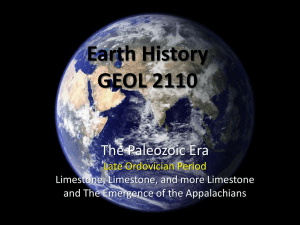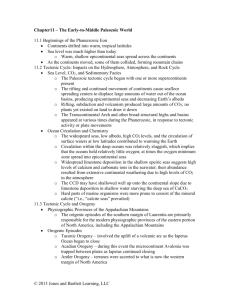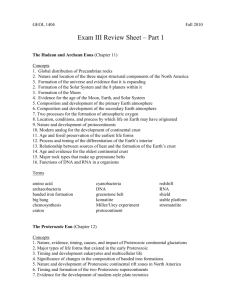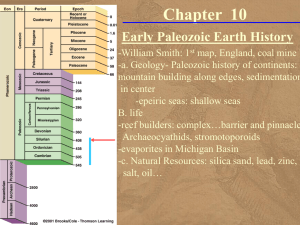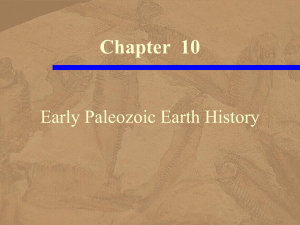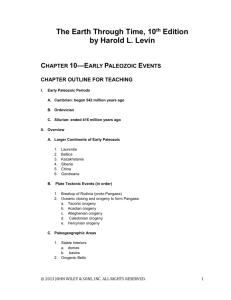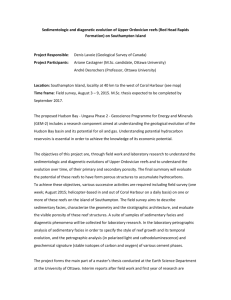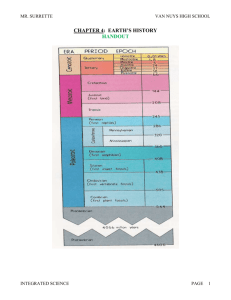chapter_10revised - LSU Geology & Geophysics
advertisement
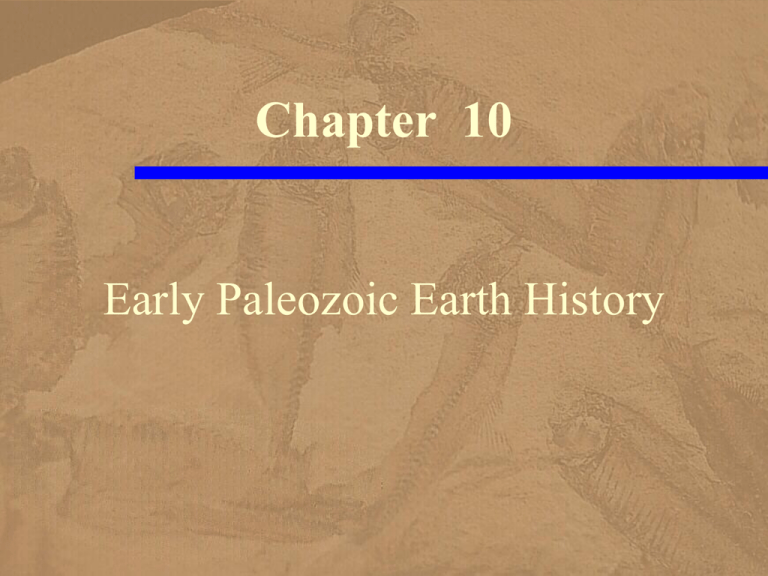
Chapter 10 Early Paleozoic Earth History The First Geologic Map • William Smith, – a canal builder, published the first geologic map – on August 1, 1815 The First Geologic Map • Five of the six geologic Paleozoic systems – Cambrian, Ordovician, Silurian, Devonian, and Carboniferous • We use the same basic geologic principles to interpret the geology of the Paleozoic Era Cratons and Mobile Belts • Pannotia supercontinent began broke apart during the latest Proterozoic • By the beginning of the Paleozoic Era, – six major continents were present • Each continent can be divided – into two major components – a craton – and one or more mobile belts Continental Architecture • Cratons typically consist of two parts – a shield – and a platform Platforms • Extending outward from the shields are buried Precambrian rocks • The sediments over the platforms were deposited in widespread shallow seas Paleozoic North America • Platform Epeiric Seas • The transgressing and regressing shallow seas – called epeiric seas – common feature of most Paleozoic cratons Mobile Belts • Mobile belts are elongated areas of mountain building activity • They are located along the margins of continents – where sediments are deposited in the relatively shallow waters of the continental shelf – and the deeper waters at the base of the continental slope • During plate convergence along these margins, – the sediments are deformed – and intruded by magma – creating mountain ranges Four Mobile Belts • Four mobile belts formed – around the margin – of the North American craton during the Paleozoic • • • • Franklin mobile belt Cordilleran mobile belt Ouachita mobile belt Appalachian mobile belt Paleozoic North America • Mobil belts Paleogeographic Maps • Geologists use – – – – – – paleoclimatic data paleomagnetic data paleontologic data sedimentologic data stratigraphic data tectonic data • to construct paleogeographic maps – which are interpretations of the geography of an area for a particular time in the geologic past Paleozoic paleogeography • The paleogeographic history – – – – – of the Paleozoic Era is not as precisely known as for the Mesozoic and Cenozoic eras in part because the magnetic anomaly patterns preserved in the oceanic crust was subducted during the formation of Pangaea • Paleozoic paleogeographic reconstructions – are therefore based primarily on • structural relationships • climate-sensitive sediments such as red beds, evaporates, and coals • as well as the distribution of plants and animals Six Major Paleozoic Continents – Baltica - Russia west of the Ural Mountains and the major part of northern Europe – China - a complex area consisting of at least three Paleozoic continents that were not widely separated and are here considered to include China, Indochina, and the Malay Peninsula – Gondwana - Africa, Antarctica, Australia, Florida, India, Madagascar, and parts of the Middle East and southern Europe Six Major Paleozoic Continents – Kazakhstan - a triangular continent centered on Kazakhstan, but considered by some to be an extension of the Paleozoic Siberian continent – Laurentia - most of present North America, Greenland, northwestern Ireland, and Scotland – and Siberia - Russia east of the Ural Mountains and Asia north of Kazakhstan and south Mongolia Paleogeography of the World • For the Late Cambrian Period Paleogeography of the World • For the Late Ordovician Period Paleogeography of the World • For the Middle Silurian Period Early Paleozoic Global History • In contrast to today's global geography, – six major continents – dispersed at low tropical latitudes • polar regions were mostly ice free • By the Late Cambrian, – epeiric seas had covered most areas of • Laurentia, Baltica, Siberia, Kazakhstania, China, Ordovician and Silurian Periods • Gondwana moved southward during the Ordovician and began to cross the South Pole – as indicated by Upper Ordovician tillites found today in the Sahara Desert • In contrast to Laurentia’s passive margin in the Cambrian, – an active convergent plate boundary formed along its eastern margin during the Ordovician – as indicated by the Late Ordovician Taconic orogeny that occurred in New England Silurian Period • Baltica moved northwestward relative – to Laurentia and collided with it – to form the larger continent of Laurasia • This collision closed the northern Iapetus Ocean • Siberia and Kazakhstania moved from – a southern equatorial position during the Cambrian – to north temperate latitudes – by the end of the Silurian Period Early Paleozoic Evolution of North America • The geologic history of the North American craton may be divide into two parts – the first dealing comings and goings of epeiric seas – the second dealing with the mobile belts In 1963, American geologist Laurence Sloss proposed that the sedimentary-rock record of North America could be subdivided into six cratonic sequences Cratonic Sequences of N. America • White areas represent sequences of rocks • That are separated by largescale Cordilleran unconorogenies formities shown in brown Appalachian orogenies Cratonic Sequence • A cratonic sequence is – a large-scale lithostratigraphic unit • greater than supergroup – representing a major transgressive-regressive cycle – bounded by craton-wide unconformities • The six unconformities extend across – the various sedimentary basins of the North American craton – and into the mobile belts along the cratonic margin The Sauk Sequence • Rocks of the Sauk Sequence – during the Late Proterozoic-Early Ordovician – record the first major transgression onto the North American craton • Deposition of marine sediments – during the Late Proterozoic and Early Cambrian – was limited to the passive shelf areas of the – Appalachian and Cordilleran borders of the craton • The craton itself was above sea level – and experiencing extensive weathering and erosion Cratonic Sequences of N. America • White areas = sequences of rocks • Brown areas = largescale unconformities • Sauk sequence The Sauk Sequence • Because North America was located – in a tropical climate at this time – but there is no evidence of any terrestrial vegetation, – weathering and erosion of the exposed – Precambrian basement rocks must have proceeded rapidly • During the Middle Cambrian, – the transgressive phase of the Sauk – began with epeiric seas encroaching over the craton Transcontinental Arch • By the Late Cambrian, – the Sauk Sea had covered most of North America, – leaving above sea level only • a portion of the Canadian Shield • and a few large islands • These islands, – collectively named the Transcontinental Arch, – extended from New Mexico – to Minnesota and the Lake Superior region Cambrian Paleogeography of North America • During this time North America straddled the equator • Transcontinental Arch The Sauk Sediments • The sediments deposited – on both the craton – and along the shelf area of the craton margin – show abundant evidence of shallow-water deposition • The only difference – between the shelf and craton deposits – is that the shelf deposits are thicker Sauk Carbonates • Many of the carbonates are – bioclastic • composed of fragments of organic remains – contain stromatolites, – or have oolitic textures • contain small, spherical calcium carbonate grains • Such sedimentary structures and textures – indicate shallow-water deposition A Transgressive Facies Model • Recall that facies are sediments – that represent a particular environment • During a transgression, the coarse (sandstone), – fine (shale) and carbonate (limestone) facies – migrate in a landward direction Cambrian Transgression • Cambrian strata exposed in the Grand Canyon • The three formations exposed – along the Bright Angel Trail, Grand Canyon Arizona Transgression • The Tapeats sediments – are clean, well-sorted sands – of the type one would find on a beach today • As the transgression continued into the Middle Cambrian, – muds of the Bright Angle Shale – were deposited over the older Tapeats Sandstone Time Transgressive Formations • Faunal analysis of the Bright Angel Shale indicates – that it is Early Cambrian in age in California – and Middle Cambrian in age in the Grand Canyon region, younger • thus illustrating the time-transgresshale sive nature of formations and facies older shale Cambrian Transgression • Cambrian strata exposed in the Grand Canyon – Observe the time transgressive nature of the three formations • The three formations exposed – along the Bright Angel Trail, Grand Canyon Arizona Same Facies Relationship • By the end of Sauk time, much of the craton – was submerged beneath a warm, equatorial epeiric sea Cambrian Facies • Block diagram from the craton interior to the Appalachian mobile belt margin – showing 3 major Cambrian facies – and the time transgressive nature of the units – The carbonate facies developed progressively – due to submergence of the detrital source areas by the advancing Sauk Sea Upper Cambrian Sandstone • Outcrop of cross-bedded Upper Cambrian sandstone in the Dells area of Wisconsin Regression and Unconformity • During the Early Ordovician, the Sauk Sea regressed. • The rocks exposed were predominately – limestones and dolostones – that experienced deep and extensive erosion • The resulting craton-wide unconformity – marks the boundary between the Sauk – and Tippecanoe sequences Ordovician Period • Paleogeography of North America – showing change in the position of the the equator • The continent – was rotating counterclockwise Cratonic Sequences of N. America • White areas = sequences of rocks • brown areas = largescale unconformities • Regression • Tippecanoe sequence The Tippecanoe Sequence • A transgressing sea deposited the Tippecanoe sequence over most of the craton – Middle Ordovician-Early Devonian • The Tippecanoe basal rock is the St. Peter Sandstone, – – – – – an almost pure quartz sandstone occurs throughout much of the mid-continent resulted from numerous cycles of weathering and erosion of Proterozoic and Cambrian sandstones deposited during the Sauk transgression Transgression of the Tippecanoe Sea • Resulted in the deposition of • the St. Peter Sandstone – Middle Ordovician • over a large area of the craton St. Peter Sandstone • Outcrop of St. Peter Sandstone in Governor Dodge State Park, Wisconsin The Tippecanoe Sequence • The Tippecanoe basal sandstones were followed by widespread carbonate deposition • The limestones were generally the result of deposition – by calcium carbonatesecreting organisms such as • • • • corals, brachiopods, stromatoporoids, and bryozoans Tippecanoe Reefs and Evaporites • Organic reefs are limestone structures – constructed by living organisms • Reefs appear to have occupied – the same ecological niche in the geological past Modern Reef Requirements • Present-day reefs – grow between 30 degrees N and S of equator • Reefs require – warm, clear, shallow water of normal salinity for optimal growth Present-Day Reef Community • with reef-building organisms Reef Environments • Block diagram of a reef showing the various environments within the reef complex Barrier Reefs – typically long linear masses forming a barrier between – a shallow platform – a deep marine basin • Reefs create and maintain a steep seaward front – that absorbs incoming wave energy • As skeletal material breaks off – from the reef front, – it accumulates along a fore-reef slope Barrier Reef • Barrier Reef • Fore-reef slope The Lagoon • The lagoon area is a low-energy, – quiet water zone where fragile, – sediment-trapping organisms thrive • The lagoon area can also become the site – of evaporitic deposits – when circulation to the open sea is cut off • Modern examples of barrier reef systems – are the Florida Keys, Bahama Islands, – and Great Barrier Reef of Australia Ancient Reefs • Reefs have been common features since the Cambrian • The first skeletal builders of reef-like structures – were archaeocyathids Stromatoporoid-Coral Reefs • Beginning in the Middle Ordovician, – stromatoporoid-coral reefs became common – similar reefs throughout the rest of the Phanerozoic Eon Michigan Basin Evaporites • Michigan Basin – a broad, circular basin surrounded by large barrier reefs • Reef growth caused restricted circulation – and precipitation of Silurian evaporates within Upper Tippecanoe sequence of the basin Silurian Period • Paleogeography of North America during the Silurian Period • Reefs developed in the Michigan, Ohio, and Indiana-IllinoisKentucky areas Northern Michigan Basin • Northern Michigan Basin sediments during the Silurian Period Stromatoporoid Reef Facies • Stromatoporoid barrierreef facies of the Michigan Basin Evaporite • Evaporite facies Carbonate Facies • Carbonate Facies Silled Basin Model • Silled Basin Model for evaporite sedimentation by direct precipitation from seawater – Vertical scale is greatly exaggerated Basin Brines • Because North America was still near the equator during the Silurian Period, – temperatures were probably high Order of Precipitation – calcium carbonate first, – followed by gypsum – and lastly halite Reefs in a Highly Saline Environment? • Organisms constructing reefs could not have lived in such a highly saline environment The End of the Tippecanoe Sequence • During this regression, – marine deposition was initially restricted to – a few interconnected cratonic basins By the Early Devonian, – the regressing Tippecanoe Sea retreated to the craton margin – exposed an extensive lowland topography The Appalachian Mobile Belt • the first Phanerozoic orogeny – began during the Middle Ordovician Mountain Building • part of the global tectonic regime – that sutured the continents together, – forming Pangaea by the end of the Paleozoic • The Appalachian region – throughout Sauk time, – was a broad, passive, continental margin Iapetus Ocean • During this time, – the Iapetus Ocean was widening along a divergent plate boundary • the Appalachian mobile belt was born with the onset of subduction of the Iapetus plate beneath Laurentia Appalachian Mobile Belt • Evolution of the Appalachian mobile belt • Late Proterozoic opening of Iapetus Ocean – with passive continental margins – and large carbonate platforms The Taconic Orogeny • The resulting Taconic orogeny, – named after present-day Taconic Mountains of • eastern New York, • central Massachusetts, • and Vermont Shallow-Water Deposition • The Appalachian mobile belt – can be divided into two depositional environments • The first is the extensive, – shallow-water carbonate platform – that formed the broad eastern continental shelf – and stretched from Newfoundland to Alabama • Formed during the Sauk Sea transgression Deep-Water Deposits • Replaced by deep-water deposits (second depositional environment) during middle Ordovician characterized by – thinly bedded black shales, – graded beds, – coarse sandstones, – graywackes, – and associated volcanics • This suite of sediments marks the onset – of mountain building, the Taconic orogeny Sediment Source • Sediment shed from – the Taconic Highlands – and associated volcanoes The subduction of the Iapetus plate beneath Laurentia – resulted in volcanism and downwarping of the carbonate platform Appalachian Mobile Belt • Middle Ordovician transition to convergence resulted in orogenic activity Orogeny Timing • Other evidence in the area from present-day Georgia to Newfoundland includes – volcanic activity in the form of deep-sea lava flows, – volcanic ash layers, – and intrusive bodies • These igneous rocks show a clustering – of radiometric ages between 440 to 480 million years ago • In addition, regional metamorphism – coincides with the radiometric dates Queenston Delta Clastic Wedge • The clastic wedge resulting from the erosion – of the Taconic Highlands – referred to as the Queenston Delta Queenston Delta Clastic Wedge • Queenston Delta clastic wedge – consists of thick, coarsegrained detrital sediments nearest the highlands – and thins laterally into finer-grained sediments on the craton • Taconic Highlands A European Orogeny • As the Iapetus Ocean narrowed and closed, – another orogeny also occurred in Europe during the Silurian (Caledonian Orogeny) Caledonian Orogeny • The transition to convergence resulted in orogenic activity in North America and Europe – Caledonian Orogeny – was a mirror image of the Taconic Orogeny Early Paleozoic Mineral Resources • Early Paleozoic-age rocks contain a variety of important mineral resources, including – sand and gravel for construction, – building stone, – and limestone used in the manufacture of cement • An Important sources of industrial or silica sand is – the Middle Ordovician St. Peter Sandstone Salt and Oil • Thick deposits of Silurian evaporites, – mostly rock salt (NaCl) – and rock gypsum (CaSO4•H2O) altered to rock anhydrite (CaSO4) – and are important sources of various salts • In addition, barrier and pinnacle reefs – are reservoirs for oil and gas in Michigan and Ohio Summary • Six major continents existed – at the beginning of the Paleozoic Era – four of them were located near the paleoequator • During the Early Paleozoic — CambrianSilurian – Laurentia was moving northward – and Gondwana moved to a south polar location, – as indicated by tillite deposits Summary • Most continents consisted of two major components – a relatively stable craton over which epeiric seas transgressed and regressed, – surrounded by mobile belts in which mountain building took place • The geologic history of North America – can be divided into cratonic sequences – that reflect cratonwide transgressions and regressions Summary • The Sauk Sea was the first major transgression onto the craton • At its maximum, it covered the craton – except for parts of the Canadian Shield – and the Transcontinental Arch, • a series of large northeast-southwest trending islands • The Tippecanoe sequence began with – deposition of an extensive sandstone over – the exposed and eroded Sauk landscape Summary • During Tippecanoe time, – extensive carbonate deposition took place • In addition, large barrier reefs – enclosed basins, – and resulted in evaporite deposition within these basins • The eastern edge of North America – was a stable carbonate platform during Sauk time Summary • During Tippecanoe time – an oceanic-continental convergent plate boundary formed, – resulting in the Taconic orogeny, • the first of several orogenies to affect the Appalachian mobile belt • The newly formed Taconic Highlands – shed sediments into the western epeiric sea – producing the Queenston Delta, a clastic wedge Summary • Early Paleozoic-age rocks contain a variety of mineral resources including – – – – – – building stone, limestone for cement, silica sand, hydrocarbons, evaporites and iron ores
